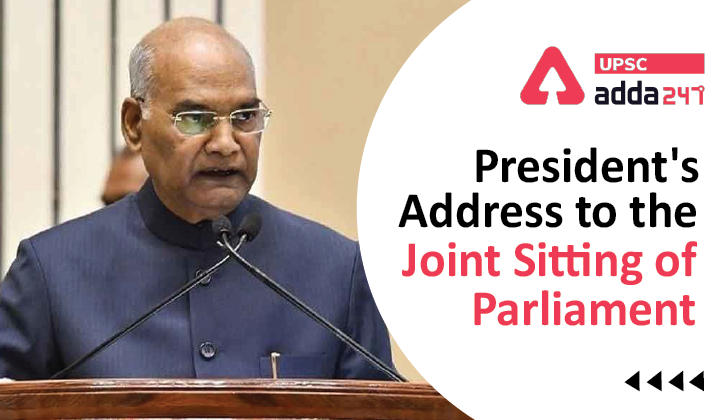Table of Contents
Context
The Budget session of Parliament begins today(January 31, 2022) with the President addressing a joint session.
Constitutional Provisions for the special address by the President
- According to Clause (1) of Article 87 of the Constitution, at the commencement of the first session after each general election to the House of the People and at the commencement of the first session of each year, the President shall address both Houses of Parliament assembled together and inform Parliament of the causes of its summons.
- Such an Address is called ‘special address’; and it is also an annual feature.
- No other business is transacted till the President has addressed both Houses of Parliament assembled together.
What Article 86(1) Says?
- Article 86(1) of the Constitution provides that the President may address either House of Parliament or both Houses assembled together, and for that purpose require the attendance of members.
- However, since the commencement of the Constitution, there has not been any occasion when the President has addressed either House or both Houses assembled together, under the provision of this article.
What if Lok Sabha is Already Dissolved?
- President’s Special Address has to be to both Houses of Parliament assembled together.
- If at the time of commencement of the first session of the year, Lok Sabha is not in existence and has been dissolved, and Rajya Sabha has to meet, Rajya Sabha can have its session without the President’s Address.
- This happened in 1977 when during the dissolution of Lok Sabha, Rajya Sabha had its session on 28 February 1977 without the President’s Address.
- In the case of the first session after each general election to Lok Sabha, the President addresses both Houses of Parliament assembled together after the members have made and subscribed the oath or affirmation and the Speaker has been elected.
Ceremonies connected with the President’s Address
- The President’s Address is a solemn and formal act under the Constitution.
- Utmost dignity and decorum befitting the occasion are maintained.
- Members assemble in the Central Hall of Parliament at least five minutes before the arrival of the President.
- Members are expected not to leave the Central Hall when the President is addressing.
- The entire ceremony as also the reading of the Address takes about an hour or so.
Importance of The President’s Address
- President’s Address is the statement of policy of the Government and, as such, is drafted by the Government which is responsible for its contents.
- The Address contains a review of various activities and achievements of the Government during the previous year and sets out the policies, projects and programmes which Government of the day wishes to pursue with regard to the important national and international issues.
- The Address also indicates, in broad terms, items of legislative business which are proposed to be brought during the sessions to be held in that year.
What Happens just after the President’s Address?
- Both the Houses meet separately in their respective Chambers half-an-hour after the Address, when a copy each of the Hindi and English versions of the Address, duly authenticated by the President, is laid on the Table by the Secretaries-General of the respective Houses.
- This laying of the Address on the Table brings the House into formal possession of the Address. Thereafter, copies of the Address are distributed to members in the Lobby and/or also through the Publications Counter.
Discussion on the Address by Motion of Thanks
- Clause(2) of Article 87 of the Constitution requires that provision shall be made by the rules regulating the procedure of either House for the allotment of time for discussion of the matters referred to in the President’s Address.
- Accordingly, rules 14 to 21 of the Rules of Procedure and Conduct of Business in Rajya Sabha make provisions for the discussion of the Address.
- Under rule 15, discussion on the matters referred to in the President’s Address takes place on a Motion of Thanks moved by a member and seconded by another member.
- Members who are to move and second the Motion are selected by the Prime Minister and the notice of such a motion is received through the Ministry of Parliamentary Affairs.
Scope of discussion on President’s Address
- The scope of the discussion on the Address is very wide and members are at liberty to speak on every matter of national or international importance and other issues.
- Generally, three days are allotted for the discussion on the Motion of Thanks.
- Notwithstanding that a day has been allotted for discussion on the President’s Address, a motion or motions for leave to introduce Bills or other business of a formal character may be transacted before the House commences or continues the discussion on the Address.
- The discussion may also be postponed in favour of an urgent Government Bill or other business.
- The time allotted by the House for discussion on the Motion of Thanks is distributed amongst various parties and groups in proportion to their strength in the House.
- At the end of the discussion, the Prime Minister replies to the debate.
- Thereafter, the amendments are disposed of, and then the Motion of Thanks is put to vote in the House.
- If any of the amendments is accepted then the Motion of Thanks is adopted in the amended form.
- There have been only three instances so far, when the Motion of Thanks was adopted by Rajya Sabha with amendments(1980, 1989, & 2001)



 TSPSC Group 1 Question Paper 2024, Downl...
TSPSC Group 1 Question Paper 2024, Downl...
 TSPSC Group 1 Answer key 2024 Out, Downl...
TSPSC Group 1 Answer key 2024 Out, Downl...
 UPSC Prelims 2024 Question Paper, Downlo...
UPSC Prelims 2024 Question Paper, Downlo...
